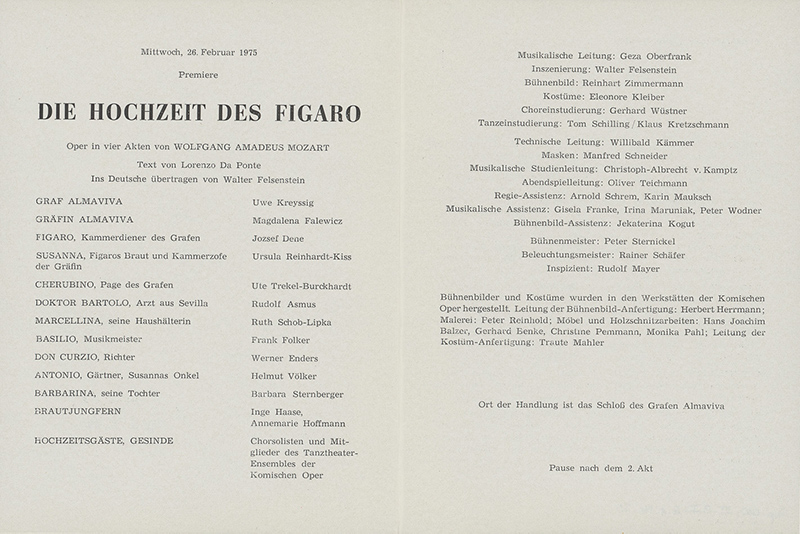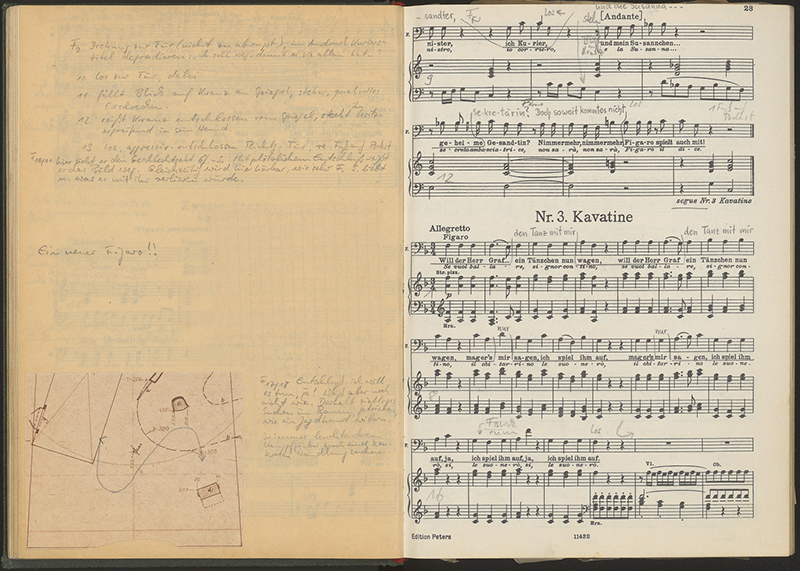Walter Felsenstein, The Marriage of Figaro (1975)
When Wolfgang Amadeus Mozart’s opera The Marriage of Figaro premièred at the Komische Oper Berlin on 26/07/1975, it was Walter Felsenstein’s last staging. The director had struggled with the work for several decades but was clearly never satisfied with what he achieved. He had already staged the work three times previously, in 1934 in Cologne, 1942 at the Salzburg Festival and 1950 at the Komische Oper, which he founded. Having fully revised the German version of the text for the Berlin staging in 1950, he based the 1975 reappraisal on a new translation. After a two-decade break, Felsenstein once again examined the text in terms of conciseness, comprehensibility and plausibility and collated it down to the rhyme structure to Lorenzo Da Ponte's libretto.

Felsenstein prepared his stagings meticulously, and The Marriage of Figaro was no different. With “dogged precision” as Hans Heinz Stuckenschmidt put it in a newspaper article, he traced the historical and the spiritual and intellectual sources of the piece, prepared a new translation, worked on the conception, analysed the work with the conductor, held discussions with the set designer and costume designer and explained his perspective to the singer-actors. This enormous workload taken on by Felsenstein in addition to his obligations as the theatre manager, in addition to guest performances and conferences, demonstrate the sense of conviction on which his work was based. In 1951, he already described the tasks of a “ strong directorial personality” as follows: Firstly, the director must express the original substance of the work to make it comprehensible to the spectator. And secondly, he is also just as responsible for making singers, conductors and set designers who are suitable for the work “deeply” familiar with the work and to create “their own deeply personal yet entirely faithful interpretation in the spirit of the theatre” (Walter Felsenstein, responses to questions on musical theatre, in: Schriften. Zum Musiktheater, Berlin 1976, p. 37).
These requirements were met through lengthy and intensive preparations and rehearsals that were unheard of at hardly any other establishment but the Komische Oper. In February 1974, one year before the première, Felsenstein spent every hour when he was free of his theatre management duties – as he put it to Reinhart Zimmermann – working on the lyrics for the Opera. He had also described his vision for the stage to the set designer and the first rehearsals began in March (trial rehearsals), as Felsenstein had not previously worked with some of the singers (Susanna and Gräfin). Felsenstein became seriously ill in the summer. But after five weeks in hospital, where he continued his work, he returned to rehearsals with detailed director’s notes. The stage result premièred on 26 February 1975 and was enthusiastically received by the press beyond the borders of the GDR; as a production that captivated through its interpretation and, in the words of Dietrich Steinbeck, delighted “in its harmony of music, word, gesture and movement”.

But for Felsenstein, the première never meant that he was finished working on the piece. Three months after the première, he spoke to Reinhart Zimmermann about changes to the set. Furthermore, the stagings at the Komische Oper were constantly being checked to ensure that audiences at later performances were also offered an unforgettable experience. So Felsenstein essentially attended the performances as an audience member in the evening, noted details of the performance and gave these critiques to those involved in the performance, though not without plenty of recognition and praise.
In July 1976, the staging was recorded. This unique film document was painstakingly restored on the initiative of Walter Felsenstein’s heirs and made available to the public on DVD (released by Arthaus Musik, 2008). In addition to the stagings of Mozart’s The Marriage of Figaro and Don Giovanni (Komische Oper 1966), it also contains the DEFA recording of The Cunning Little Vixen by Leoš Janáček (1965), Othello by Giuseppe Verdi (1969), The Tales of Hoffmann and Barbe-bleue by Jacques Offenbach (1970 / 1973) as well as the opera film of Ludwig van Beethoven’s Fidelio (1956) produced in Vienna. These productions can be seen on the big screen on a regular basis, including at the Babylon Cinema in Berlin.
The Marriage of Figaro
Opera buffa in four acts by Wolfgang Amadeus Mozart
Text by Lorenzo Da Ponte, translated into German by Walter Felsenstein
Berlin, Komische Oper
Première: 26/02/1975
Musical Director: Geza Oberfrank
Staging: Walter Felsenstein
Set Design: Reinhart Zimmermann
Costumes: Eleonore Kleiber
Television Director: Georg Mielke
Biography
Born on 30/05/1901 in Vienna – died on 08/10/1975 in Berlin
1921-1923 Training at the Academy of Drama Vienna 1927-1929 Senior director of drama and opera at Stadttheater Basel, 1929-1932 Senior Director of drama and opera and senior dramaturge at Stadttheater Freiburg, senior director of opera at the Städtische Bühnen Cologne (1932-1934) and the Städtische Bühnen Frankfurt am Main (1934-1936), 1936 excluded from the Reichstheaterkammer (Reich Chamber of Theatre), 1938-1940 senior director of operettas with opera duties at Stadttheater Zürich, 1944-1945 obligatory service at Siemens in Berlin, 1945 director at the Hebbel-Theater Berlin and the in-house acting studio, from 1947 theatre manager and head director at the Komische Oper Berlin, guest performances in Vienna, Milan, Hamburg, Stuttgart, Moscow, Munich and Budapest, among others.
1951 Corresponding member of the German Academy of Arts, from 1952-1975 member of the German Academy of Arts/GDR Academy of Arts and Vice President from 1956-1975.
Archive and collection
The Walter Felsenstein Archive contains 33 running metres and comprises documents on his 193 stagings in total focussing on his work as theatre manager and head director of the Komische Oper Berlin. The holdings include work documents such as director’s notes and piano scores, librettos, text versions, rehearsal notes, director’s journals, scripts, programmes, cast lists, posters, reviews, rehearsal and scene photos, set and costume designs, stage layouts, sound recordings and videos. They also include handwritten manuscripts and drafts of speeches and articles, extensive correspondence with institutions and private individuals, including with Rudolf Bing, Paul Dessau, Hanns Eisler, Ferenc Fricsay, Heinrich George, Hans Werner Henze, Otto Klemperer, Caspar Neher, Günther Rennert, Georg Solti and Rudolf Wagner-Régeny as well as biographical documents and awards. The holdings have been added to by collections, including draft set designs and figurines by set designer Heinz Pfeiffenberg and photographs from the Komische Oper photo archive.
History of the holdings
The Walter Felsenstein Archive was founded in January 1973 on behalf of the GDR Academy of Arts at the Komische Oper Berlin. The director provided his work materials on his artistic productions. In addition to this, all available documents on his work were collected, compiled and researched over the years. In 1998, the holdings were relocated to the Akademie der Künste rooms and have been managed and made available to the public there since then.
